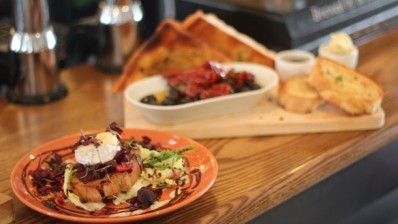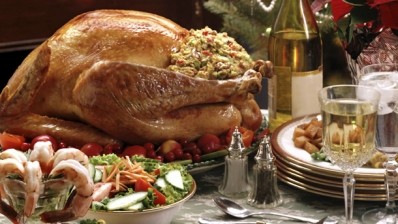Dreaming of a gluten-free Christmas?

There’s a chill in the air. Nights are getting longer, the sun appears to have disappeared behind a seemingly unending veil of clouds and pub kitchens are already gearing up for Christmas — arguably the most challenging and lucrative of holidays for the sector.
But it’s not just a challenging time for operators. Christmas meals out can be risky territory for customers with coeliac disease, or those who adhere to a gluten-free diet.
Worth the effort
Roughly one in every 100 Brits is estimated to have coeliac disease, according to figures from Coeliac UK. The disease, caused by an intolerance to gluten, can cause a range of symptoms for sufferers.
Symptoms can include anything from bloating, diarrhoea, nausea, wind and constipation to weight loss, hair loss and anaemia. And on top of that, approximately only 24% of coeliac sufferers are currently diagnosed.
So combined with the fact that gluten-free diets have become massively popular as a lifestyle choice during the past few years, gluten-free consumers present a sizeable market — estimated to be worth roughly £365m and expected to double in size by 2019.
However, recent research by Knorr reported that 28% of operators still didn't have a single gluten-free dish on their menu, with roughly half claiming there wasn't enough inspiration to create gluten free dishes.
“Christmas is a time when more people eat out and people with coeliac disease should not be ignored,” says Kate Newman of Coeliac UK.
“It is important that pubs realise the growing market for catering for those on a gluten-free diet, which can be easily undertaken by just taking on board a few adjustments to their menus and making sure that gluten-free preparation is managed effectively — but it is worth making the effort.
“Catering businesses can benefit significantly,” she says. “Research shows that people with coeliac disease — and the friends and family they eat out with — are worth a potential £100m a year to venues going the extra mile.”
Growth on menus
It’s a market that, according to celebrity chef and self-styled spokesperson for gluten-free cooking, Phil Vickery, is eager to reward operators sensitive to their plight with loyalty and continuous trade.
Top tips for gluten-free Christmas dishes
- Gluten-free bread can be used in bread sauce and gravy can be made with cornflour instead of wheat flour.
- Avoid cross contamination during cooking and plating — some coeliacs are so sensitive that even the smallest amount of gluten can trigger a reaction.
- Always ask ahead about dietary requirements.
- For gluten-free baking, don’t forget to add xanthan gum. The starch, produced by fermentation, is used in many household products. It improves the texture and longevity of the finished product.
Vickery previously told the Publican’s Morning Advertiser he thought there was a level of “ignorance and arrogance” among chefs when it came to cooking gluten-free food.
“There is a massive growth in ‘free-from’ foods,” adds Gail Bridgeman of Bidvest Foodservice. “More than 22% of the UK population considers themselves to have a food allergy or intolerance, and almost one third of UK households include at least one allergy or intolerance sufferer.
“In fact, the growth has been exceptional, with a 300% increase in the number of gluten-free items on restaurant menus since 2011 — and this won’t be too dissimilar in pub outlets.”
Deciding vote in ‘glutenomics’
Since opening two years ago, London freehouse, the Truscott Arms, which came 10th in this year’s Top 50 Gastropubs awards, has served a wide range of gluten-free dishes.
Last year, its Christmas menu included gluten-free options such as smoked Scottish salmon pillows with chive and cream cheese, organic turkey with caramelised sprouts, chestnut and mushroom stuffing, roasted vegetable and turkey jus and cauliflower soup with textures of cauliflower and olive oil.
“The one thing we’ve never cracked is a gluten-free Yorkshire pudding,” says owner Andrew Fishwick. “They just don’t turn out properly, and wherever there’s a compromise on quality or taste we won’t do it.”
The Truscott Arms has been lauded for the large variety of gluten-free options it serves, with coeliac customers travelling from as far away as North America and Sweden to try it out.
Fishwick adds: “[Catering to gluten-free diets] has been amazing for business. My sister-in-law coined the term ‘glutenomics’ — by which if you’re coeliac, the chances are that you get to choose where to eat because you need somewhere that can cater for you.
“Coeliacs tend not to dine alone, so you can end up with five or six more covers by catering to that one person’s needs.”
He says it’s surprisingly easy to prepare a kitchen to start serving gluten-free Christmas dishes and gluten-free food in general alongside a standard food offer.
“It only requires a little bit of thought,” he says. “And a little bit of training for the chefs in terms of cross contamination. Other than that, it’s simple.”
Meat’s off the menuRecent research reported that 54% of people, not just vegetarians, thought there were not enough meat-free dishes on Christmas menus.
Younger customers (aged 18 to 34) were most vocal, with a third of those asked saying four or more meat-free dishes should be available.
“Our research proves that caterers must focus on offering a greater choice of vegetarian options,” says William Matier, managing director at supplier Vegetarian Express. “Especially in light of the fact that it’s the 18 to 34-year-olds — a crucial and significant group for out-of-home spending — who are driving this demand for a greater selection of dishes. Catering for vegetarians doesn’t have to be difficult or stressful.”
The kitchen at the Prince George, Brighton, offers exclusively vegetarian food under chef Mark Richardson.
The pub’s Christmas menu includes dishes such as ginger beer-battered halloumi bites with tartar sauce and mixed leaves; chestnut mushroom, cashew nut and tarragon wellington with new potatoes; apple and pear-braised red cabbage, coriander carrots and gravy; and sweet potato lime and coriander pancakes with Asian pesto and roasted red pepper cream.







